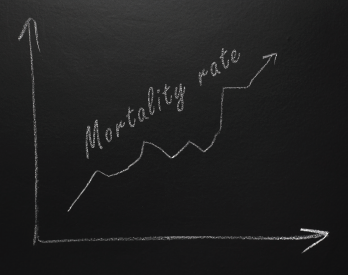
GTbov / shutterstock.com
A study published in Annals of Internal Medicine in December 2017 looked at trends in lupus mortality over a 46-year period. The researchers say they set out to close some knowledge gaps.
“There [was] a knowledge gap relating to the large differences we see in death rates from one study to another, which could have been due to different methodologies used in different studies,” says Ram R. Singh, MD, professor of medicine and pathology at the David Geffen School of Medicine at the University of California, Los Angeles (UCLA) and the study’s senior author. “Most of these studies were done in rheumatology centers and didn’t capture the death rates in the general population. There were no studies covering the entire U.S.”
“To overcome these limitations, we utilized mortality data from the Centers for Disease Control and Prevention’s National Vital Statistics System, encompassing more than 99% of all deaths in the 50 states and District of Columbia from the years 1968 through 2013,” says lead author Eric Y. Yen, MD, a clinical instructor at the UCLA Department of Medicine.
More than 68,000 deaths from systemic lupus erythematosus (SLE) and 100,851,288 non-SLE deaths were reported during that period. The researchers used JointPoint trend analysis of annual age-standardized mortality rates (ASMR) for both disease- and non-disease-related causes by sex, race/ethnicity and geographic region.
“The number of deaths reported in this study is large,” says Dr. Singh. “There were more than 50,000 reports where SLE was the underlying cause of death, according to the death certificate, and another 18,000 where SLE was a contributing or secondary cause of death. Using 46 years of data, this was a large study of long duration.”
Death Rate Comparisons

Dr. Singh (left) and Dr. Yen (right)
During the period of interest, five- and 10-year survival rates for SLE improved from less than 50% during the 1950s to around 90% in the 1980s. But the SLE ASMR decreased less than the non-SLE ASMR, with a 34.6% increase in the ratio of SLE to non-SLE ASMR. The ASMR for the general population went down every year, while SLE ASMR decreased between 1968 and 1975, increased between 1975 and 1999 and then decreased again for the rest of the study period.
Among those dying from other causes, the death rate dropped by 44% from 1968–2013. In contrast, in lupus it dropped only 24% over the same period.
“When we calculated the ratio of decrease in death rate from SLE compared to decrease in death rate in the general population, it comes out that the differential is 35% higher in 2013 than it was in 1968,” says Dr. Singh. “So lupus patients are falling behind relative to people who do not have lupus.”
Year-to-year rate changes also proved interesting. Because of the smaller number of people enrolled in other studies, those researchers usually had to bunch data in five- to 10-year periods. According to Dr. Singh, his study appears to be first in which the size of the study population was large enough to break changes down on a yearly basis.
Similar patterns appeared with both sexes, among African Americans and those residing in the South. However, statistically significant increases in SLE ASMR did not occur among white persons over the entire 46-year period.
“We also noticed significant regional variation in SLE mortality in each racial group,” says Dr. Yen. “Where you live matters. People living in the South and the West experienced the highest mortality risk.”
Females, African Americans and residents of southern states had higher SLE ASMRs and larger cumulative increases in the SLE/non-SLE ASMR ratios (31.4%, 62.5% and 58.6% respectively) than males, other ethnicities/races and other regions.
The researchers next looked at the results of multiple logistic regression analysis. These showed independent associations of race, sex and region with SLE mortality risk, and the researchers noted significant racial/ethnic differences in associations of SLE mortality with sex and region.
“Much of gender difference is [because] women are diagnosed more often with SLE than men,” says Dr. Singh. “African Americans and Hispanics have one-third higher rates than whites. There was also an increase in death rate in those over 65 years of age compared to those who are younger.”
One study limitation was the use of death certificates as the data source. Some studies suggest that perhaps as many as 50% of lupus patients do not have the disease included on their death certificates. This may cause an underestimation of the death rate, leading Dr. Singh to suggest educating primary care physicians and internists to recognize SLE as an important cause of death and to record SLE on death certificates.
Important Conclusions
“One message is that we have done well in the short term, and fewer people are dying in the first few years after diagnosis of lupus and, thus, living longer,” says Dr. Singh and Dr. Yen. “However, death rates in this group haven’t fallen as much as the decrease in the general population. These observations do add to the urgency to the question of why, and show we need to find better ways to manage SLE.”

Dr. Bartow
Thomas Bartow, MD, FACP, is clinical lead in rheumatology at the Marshfield Clinic Health System in Marshfield, Wis. He notes the study was well done for the question it asked.
“This study is a very imaginative way to ask the very basic question of whether we are doing better in keeping SLE patients alive,” says Dr. Bartow, who was not involved in the study. “It is a very fundamental question to ask, and I think they went about getting their answer in a very ambitious way, going all the way back to 1968.”
Although he notes the increase in deaths from 1975–1999, he thinks this may be less of an indicator of treatment and more of an indicator of case finding. He points out that the time of the bump in death rates was about the time improvements in lab testing began impacting diagnosis. These advances may also explain the lowering of death rates from 1999 forward.
“From the clinician’s viewpoint, it is [now] much easier to diagnose lupus earlier, and this means we are seeing patients with much milder disease than before, but on the other hand, we are seeing more of them,” Dr. Bartow says. “The encouraging thing is, we are doing better. The death rate is going down, so I think we are on the right track.”
Kurt Ullman has been a freelance writer for more than 30 years and a contributing writer to The Rheumatologist for 10 years.
Reference
- Yen EY, Shaheen M, Woo JMP, et al. 46-Year trends in systemic lupus erythematosus mortality in the United States, 1968 to 2013: A nationwide population-based study. Ann Intern Med. 2017 Dec 5;167(11):777–785.

